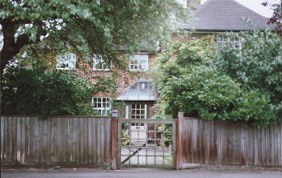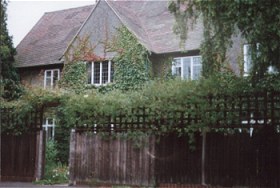Return to Oxford
Tolkien the teaching professor
Tolkien was a good teacher, becoming famous for his lectures on Beowulf where he made his students understand that it was not just a set text, but actually an incredibly powerful piece of dramatic poetry. This idea was only exmphasised by his wonderful sense of theatrical delivery.
“He could turn a lecture room into a mead hall in which he was the bard and we were the feasting, listening guests.”
One student, however, recalled thinking that Tolkien was as mad as a hatter when he was lecturing. He would leave the subject of the lecture at will, and start talking about goblins and elves, half mumbling to himself, and only half talking to the class.
He was called on by university statutes to give a minimum of 36 lectures a year, but he believed that was not enough to cover his subjects in depth and in his second year in the job, he gave 136 lectures. While this was partially because there were comparatively few people who could lecture on Anglo-Saxon and Middle English, when Tolkien was given another philologist (Charles Wrenn) to assist him, he still gave more than twice the number of statutory lectures each year.
Tolkien’s writing and poetry reinforced his skills in philology, meaning that he not only studied words, but actually used them for his own means. As such, he could not only show his pupils why an author had chosen a particular form of expression, but then how it fitted into his scheme of imagery.
He was also an excellent teacher when working solely with the mechanics of language, with CS Lewis suggesting that this was partly due to the fact that he was a linguistic inventor as well as a student of language – he had “been inside language.”
Tolkien the philologist
Tolkien almost single-handedly founded a new school of philology as no-one before him had ever used such humanity and emotion in the subject. His literary genius came shining through in the grace of expression, elegant comparisons and powerful imagery of his philological works.
He was extraordinarily scrupulous in his research, even by the exacting standards of philology, and his concern for accuracy was doubly valuable as it was coupled with a flair for detecting patterns and relations.
Tolkien the examiner
Tolkien continued to undertake a great deal of freelance work as an external examiner to supplement his income. In the 1920s and 1930s, he made frequent visits to many of the UK universities and spent endless hours marking papers. In pre-war years, he also marked School Certificate papers. After WW2, however, he restricted himself to examining regularly for various colleges in Ireland, touring Eire at the same time.
Tolkien the researcher
Academic colleagues had high hopes that Tolkien would add significantly to the existing body of work concerning the early Middle English of the West Midlands – and he initially had every intention of doing so. He promised a new edition of the Cambridge manuscript of the Ancrene Wisse to the Early English Text Society and he did a great deal of research into that section of early mediaeval English. But the manuscript was not completed for many years, and the greater part of his research work was never fully realised. This was mainly due to the fact that he had chosen to devote the majority of his time to teaching, as well as his perfectionism.
CS Lewis commented that:
“His standard of self-criticism was high and the mere suggestion of publication usually set him upon a revision, in the course of which so many new ideas occurred to him that where his friends had hoped for the final text of an old work they actually got the first draft of a new one.”
Furthermore, any hint of criticism sent him into one of two opposite directions:
“He has only two reactions to criticism … Either he begins the work again from the beginning or else takes no notice at all.”
In the 1930s, however, he did manage to publish some papers that formed major contributions to scholarship. In 1934, he published a paper on the dialects of Chaucer’s “Reeve’s Tale”, and in 1936, he gave a lecture of the British Academy which was later published as “Beowulf: the Monsters and the Critics”. Both quickly became standard texts in their fields.
After EV Gordon’s early death, Tolkien realised that he wanted another working partner. He met up with Simonne d’Ardenne, a Belgian philologist who had studied Middle English with Tolkien for a year in the early 1930s. He contributed much to her edition of “The Life and Passion of St Juliene”, a mediaeval religious work written in the Ancrene Wisse dialect. They then planned to collaborate on an edition of “Katerine”, another western middle English text, but WW2 intervened, and the two could not communicate for many years. After 1945, they published a couple of short articles, but Simonne quickly realised that further collaboration with Tolkien was going to be nothing short of impossible as his mind was firmly fixed on Middle-earth, not Middle English.
Pearl and Sir Gawain
Tolkien started a translation of “Pearl” in the 1920s when he was working in Leeds, and in the 1940s, Blackwells offered to print it in return for a sum to be credited to Tolkien’s heavily overdue account at the bookshop. The translation was set in type, but Tolkien never got round to writing the introduction, and the project was abandoned.
He did, however, finish a new Gawain translation in time to be broadcast in dramatised form by the BBC in 1953. For the broadcast, Tolkien recorded a short introduction and a longer conclusion.
After the success of “The Lord of the Rings”, Allen and Unwin decided to publish a one volume edition of Tolkien’s translations of “Pearl” and “Gawain”. For this, Tolkien made extensive revisions of both, but again an introduction proved the undoing of the project. He was unsure what to write for a non-scholarly reader of the work, and the project lapsed. The book was finally published after his death, together with a modern English rendering of “Sir Orfeo” and an introduction provided by Christopher Tolkien.
Tolkien the family man

The family bought a house at 22, Northmoor Road, a road where they were to live for 21 years. While they liked their house at no. 22, when the much larger no. 20 became vacant in late 1929, they quickly moved next door. No. 20 was broad and grey, imposing in its frontage, with small leaded windows and a high slate roof.
By this time, Tolkien was entering his early thirties, and he looked just like an ordinary middle-class Englishman of light build and moderate height. He was mildly handsome, though with a long face. He could not abide any sign of affectation in dress, and he and his friends had an almost exaggerated preference for tweed jackets, flannel trousers, nondescript ties, solid brown shoes, and dull-coloured raincoats and hats.
He was notorious for speaking quickly and indistinctly, though this was not a physical problem, but rather an intellectual one – he moved so fast from idea to idea that most people found it hard to keep up with the flow. Later in his life, when he was mainly devoid of intellectual companionship, he would speak more in monologues than conversations.
Tolkien was very humble, acknowledging his own talents but not believing that they were of much importance – his eventual fame puzzled him greatly. He had little personal pride in his own character, considering himself a weak man. His sense of humour was deprecating, and he could laugh at anyone, but particularly at himself. At times, his complete lack of any sense of dignity made him behave like a schoolboy.

He always listened, taking great interest in the experiences of others, and wishing to share in any sorrows. While he was a shy man in many ways, he made friends easily – with all types of people. In his later years, he formed friendships with the taxi-drivers whose cars he hired, the policemen who patrolled round his bungalow, and the college scout that looked after him. There was no idea of condescension in these alliances – he simply liked company.
Carpenter (2002) gave a detailed view of Tolkien’s life at this point. He slept alone in a back room overlooking the garden – as Edith found his snoring tiresome, and he woke every morning at 7am. He took the boys to mass at St Aloysius’ Catholic Church before returning to breakfast at 8am. He then worked with his pupils in his study or gave lectures. His study was a room entered through a tunnel of books leading from the door into the middle of the room. Tolkien’s desk was placed in the south-facing window. Lectures were given either at his college – Pembroke – or at the Examination Schools building.
“The study was very much the centre of Ronald’s home life, and the centre of his study was his desk. Over the years the top of his desk continued to show familiar landscapes: his dark brown wooden tobacco jar, a Toby jug containing pipes and a large bowl into which the ash from his pipe was regularly knocked out. We also vividly remember a row of coloured Quink and Stevenson inks, and sets of sealing wax in different shades to match his large supply of stationery.
There were also wonderful boxes of Koh-i-Noor coloured pencils, and tubes of paint with magical names like Burnt Sienna, Gamboge and Crimson Lake.”
His lunch was taken at home everyday with Edith and the children, but he dined out once or twice a week. Often he attended meetings of the Coalbiters (Kolbitar), a club that he had founded for dons along the lines of the Viking Club. He had started the group to try and persuade his friends that Icelandic literature was worth reading in the original language, and to guide their faltering steps in translation. Members of the club included CS Lewis, George Gordon, Nevill Coghill, and CT Onions.

When Tolkien returned from socialising, Edith was generally in bed, so then he retired to his study and worked on half-finished manuscripts and stories.
He was immensely kind and understanding as a father, never reserved in his displays of private or public affection for his sons. And his joy was complete when Priscilla Mary Reuel was born in 1929.
Tolkien and leisure time
In 1932, Tolkien bought his first car, a Morris Cowley which was nicknamed “Jo” after the first two letters of its registration. After learning to drive, he took the whole family to visit Hilary at his Evesham fruit farm, and on that short journey “Jo” sustained two punctures and managed to knock down part of a dry-stone wall near Chipping Norton. Tolkien’s driving, though enthusiastic, was certainly not skilful.
By WW2, Tolkien had realised the damage that the car engine – and the miles of new roads – were doing to his beloved rural England, and he refused to purchase another car, or even drive again.
He was an enthusiastic gardener, just like Edith, and they split the garden tasks between them. Tolkien concentrated mainly on the roses and the lawn. 20, Northmoor Road was much loved for its garden:
“John and Ronald worked at landscaping and redesigning the garden over many years, turning the rather decrepit tennis court at the top into a vegetable garden: an important aseet during the war years that were to follow. … In a side garden, Edith had an aviary, in which budgerigars, canaries and other exotic birds lived during the summer months, being taken indoors for the winter. In war-time, the aviary was turned into a hen-house and the fowls and their eggs became an important part of the household economy.”
He also enjoyed visits to the theatre, even though he often declared that he did not approve of Drama. The family also hired a punt for the summer months. His love of beer was indulged by keeping a barrel in the coal-hole behind the kitchen.
One memorable family holiday took place in 1932, when the family went to Lamorna Cove, in Cornwall, along with Charles Wrenn and his family. One day, Wrenn and Tolkien had a swimming race wearing panama hats and smoking pipes while they swam. And in Lamorna, a legend was born. There was a curious old man – a local character – who used to go round swapping weather wisdom and local gossip. To amuse the boys, Tolkien named him Gaffer Gamgee. The name became part of family lore, and it was affixed to all old men of that kind.









